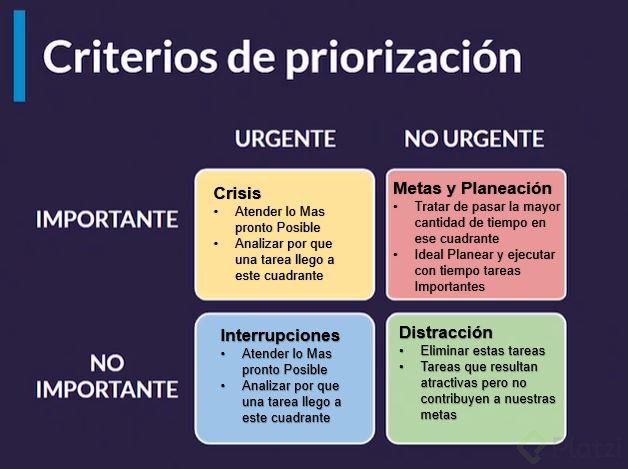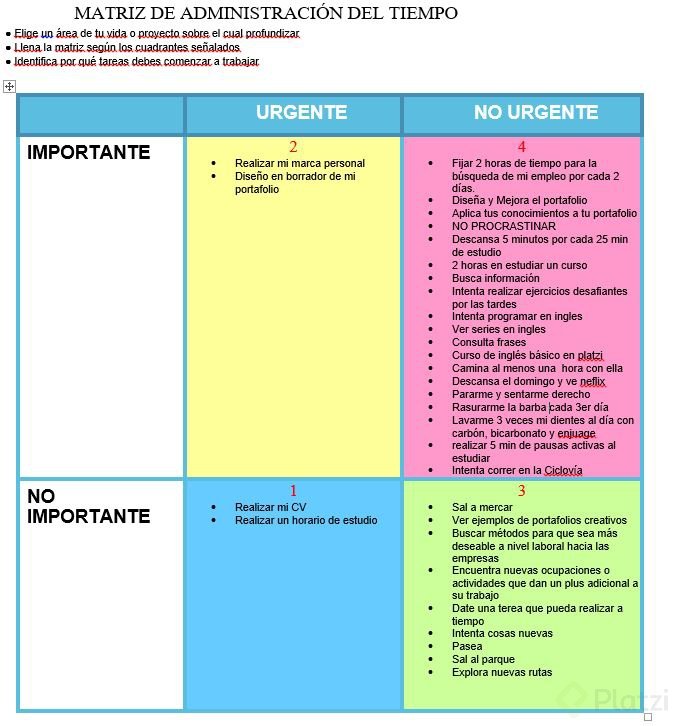Methods for EFFICIENT WORK - Prioritize. [ESP] Métodos para EL TRABAJO EFICIENTE - Priorizar.

LINK
The prioritization consists of detailing it urgent since this prevails over the important thing.
In order for your to-do list to be effective enough to allow you to work effectively and efficiently, being able to plan in the short term either in days or weeks is not only feasible but is also recommended.
When you start each Eisenhower-based to-do list on your daily weekly to-do list that we've seen in previous posts, prioritize the most urgent and important tasks, then everything else.
The most important topics are those that must be carried out sooner or later as they will allow you to achieve your long-term goals. Urgent tasks, on the other hand, are those that can generate negative consequences and are not solved in the established time, such as deadlines set with clients or deadlines that cannot be negotiated since otherwise they cannot be carried out. The Eisenhower principle recommends that these tasks be prioritized and that if there are doubts regarding important matters but they are not urgent that they be moved to a different list, either daily or weekly.
This Eisenhower principle can be represented as a matrix separating the categories important and not important as well as urgent and non-urgent, resulting in four fields that are marked in alphabetical order A is what has the highest priority and D is what can be neglected .

LINK
In all aspects, whether in studies or experience of those who perform the best time management, it has shown that the daily prioritization of tasks is the approach to the urgent. When we carry out a weekly plan it is also possible to accommodate those important tasks that will lead us to long-term success as the daily and weekly events are linked to each other.
Like the Eisenhower matrix, prioritization also consists of delegating those tasks that cannot be carried out by ourselves and this includes the following:
Routine tasks.
Tasks that must be performed by experts.
Very precise questions that need to be clarified.
Work for example, create an initial draft for a certain presentation.
ESPAÑOL
La priorización consiste en detallarlo urgente ya que este prevalece sobre lo importante.
Con el objetivo de que tu lista de tareas sea lo suficientemente efectiva para permitirte trabajar de manera eficaz y eficientemente pudiendo planificar en corto plazo ya sea en días o semanas no es solamente factible sino que también es recomendable.
Cuando comienzas cada planificación de las tareas pendientes de la lista diaria semanal conforme al principio de Eisenhower que hemos visto en las publicaciones anteriores hay que priorizar las tareas más urgentes e importantes y luego todo lo demás.
Los temas más importante son esos que deben ser llevados a cabo tarde o temprano ya que te permitirán alcanzar tus metas a largo plazo. Las tareas urgentes por otra parte son las que te pueden generar consecuencias negativas y no se solucionan en el tiempo establecido como por ejemplo los plazos fijados con clientes o plazos que no se pueden negociar ya que de otra manera no se pueden llevar a cabo. El principio de Eisenhower nos recomienda que estas tareas se prioricen y que si existen dudas con respecto a los asuntos importantes pero no son urgente que se trasladen a otra lista diferente ya sea diaria o semanal.
Éste principio Eisenhower se puede representar como una matriz separando en las categorías importante y no importante así como también urgente y no urgente teniendo como resultado cuatro campos que se marcan en orden alfabético A es lo que tiene mayor prioridad y D es lo que puede ser desatendido.

LINK
En todos los aspectos, ya sean en estudios o experiencia de quienes realizan la mejor gestión del tiempo ha demostrado que la priorización diaria de tareas es el abordaje de lo urgente. Cuando realizamos un plan semanal también es posible acomodar aquellas tareas importante que nos llevarán al éxito a largo plazo como los eventos diarios y semanales se vinculan entre sí.
Así como la matriz de Eisenhower la priorización también consiste en delegar aquellas tareas que no pueden ser llevadas por nosotros mismo y esto incluye lo siguiente:
Las tareas rutinarias.
Las tareas que deben ser realizadas por expertos.
Las cuestiones muy precisas que deben ser aclaradas.
El trabajo por ejemplo, crear un borrador inicial para una presentación determinada.